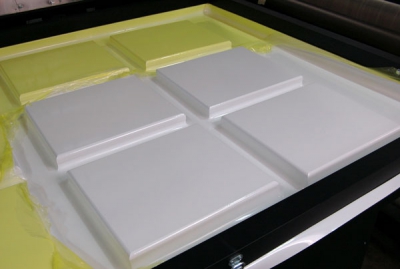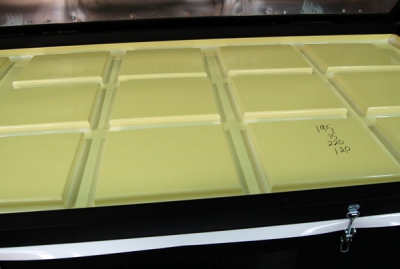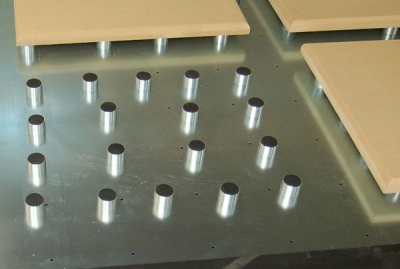SECTION 1: MATERIAL IDENTIFICATION AND USE
Veneer Bond Dry Resin: Pure White
UF253-S Urea Formaldehyde Resin Spray Dried Powder
Read and understand this before using or handling product.
For emergency purposes: PRO-GLUE, a product line of VAC-U-CLAMP
PRO-GLUE Emergency phone: 888-342-8262
Product Type: Adhesive
General product use: Veneering / Laminating
Chemical Name: Urea Formaldehdye Resins; Amino Resins
Product Codes: UF253, BTLU253, 253
CAS Registry No.: Urea Resin; 9011-05-6 Formaldehyde; 50-00-0
Molecular Weight: Not Available
Material Uses – Hot or Cold Curing Wood Adhesive
NFPA Ratings: Health: 2 Flammability: 1 Reactivity: 0 Protection: 0 0 weak → 4 severe
NPCA-HMIS Ratings: Health: 2 Flammability: 1 Reactivity: 0 Protection: 0 0 weak → 4 severe
SECTION 2: EXPOSURE HAZARDS INFORMATION
SIGNAL WORD: “DANGER”
PICTOGRAMS:

HEALTH RISK CARCINOGEN

EXCLAMATION POINT SENSITIZER; IRRITANT SKIN, RESPIRATORY
FOR INDUSTRIAL USE ONLY
THIS RESIN CONTAINS FORMALDEHDYE WHICH IS LISTED BY CALIFORNIA PROP. 65 AS CAUSING CANCER
Appearance and Odor: Tan to Brown free flowing powder that will form a crust on the surface by absorbing moisture from the air. Has a slight chemical odor.
Primary Routes of Entry and exposure: Eyes, Inhalation, Skin contact
Inhalation: Dust or vapors can cause irritation. Inhalation may aggravate colds, allergies, asthma, emphysema and psoriasis. Material vapors maybe carcinogenic. See chronic hazards this section.
Skin Contact: Repeated skin contact can cause sensitization and dermatitis due to Formaldehdye
Eye Contact: If powder gets into eyes it can cause severe irritation.
Ingestion: Ingestion of material is not expected to occur during the normal use of this product. If ingested it may cause stomach and intestinal irritation, vomiting, diarrhea, sweating, weakness, and headache. Avoid swallowing if a large amount of material gets into mouth.
CHRONIC HAZARDS: Formaldehyde is listed as a human carcinogen, Group – 1, by IARC and OSHA and a suspected carcinogen by NTP. Evidence is based upon animal testing and data on human is inadequate. Formaldehdye vapors have been found to be carcinogenic to animals and are considered carcinogenic to humans by inhalation. While the amount of formaldehdye in this product is small < 2% exposure should be minimized or avoided and recommended personal protection measures should be followed.
IN ALL CASES WHERE SYMPTOMS AND EXPOSURE EFFECTS PERSIST GET MEDICAL ATTENTION.
SECTION 3: COMPOSITION / INFORMATION ON INGREDIENTS
Urea Formaldehyde Resin:
Concentration 90 – 95%
CAS No.: 9011-05-6
Formaldehyde:
Concentration: < 2%
CAS No. : 50-00-0 EINECS (EC) No.: 200-001-8
Carcinogen: Yes IARC, NTP, OSHA, ACGIH (Group 1)
Ammonium Sulfate:
Concentration: < 3%
CAS #: 7783-20-2 EC# 231-984-1
Carcinogen: No IARC, NTP, OSHA, ACGIH (Group 1)
Irritant to eyes, respiratory system and skin
SECTION 4: FIRST AID MEASURES
Eye Contact: Flush eyes with water for 15 minutes. Get prompt medical attention.
Skin Contact: Wash affected areas for 15 minutes with soap and water while removing contaminated clothing. If skin problems occur get medical attention. Launder clothing before using them again.
Inhalation: Move to fresh air. Use artificial respiration if needed. Get medical attention.
Ingestion: Rinse mouth. Drink large quantities of water and induce vomiting. Do not give water or induce vomiting with a drowsy, convulsive, or unconscious person. Get medical attention.
SECTION 5: FIRE FIGHTING MEASURES
Flammability: not flammable under normal conditions
Means of Fire Extinctions: Removal of heat (water spray) and displacement of oxygen for combustion.
Special Procedures: NIOSH approved self contained breathing apparatus. Complete skin protection. Treat as ordinary combustible powder. Possible dust explosion if dispersed in air in large quantities. If dispersion in air is likely UFMW51 can wetted down with water to prevent it from floating into the air as dust.
Flash Point, °C, and method: >200°F by Closed Cup
Upper Explosion Limit, % volume: not available
Lower Explosion Limit, % volume: not available
Explosion Data: not available
Auto ignition Temperature: not available
Hazardous Combustible Products: Carbon Dioxide-CO2, Carbon Monoxide-CO, Oxide of Nitrogen, Formaldehdye
Rate of Burning: Not Available
Extinguishing Media: Water Fog, CO2, foam, dry chemical
Sensitivity to static discharge: Not applicable
SECTION 6: ACCIDENTAL RELEASE MEASURES
Spill and leak procedures: see section 8 for type of protective equipment needed. Remove ignition sources. Provide adequate protective equipment and ventilation. Dike or surround spill with clean up material to prevent contamination of sewers, streams, ponds, or lakes by material. It is best to plan to collect spill up dry using brooms, dust pans and shovels. Collect material for reclaim and place in covered waste containers. Avoid generating dust. The material has some water solubility and wash water may have to be collected as a waste if water is used. Floors may become slippery with just the dry powder. The reportable quantity for formaldehdye is 100 pounds. About 5,000 lbs. of this material contains 100 lbs. of non reacted formaldehdye. Dispose of waste material as required by your local state and federal regulations.
Containers leaks: Leaks can be slowed by plugs. Powder will often prevent tape or glue from sticking to the surface of the container. If possible place container on side with leak facing up to stop leak. Clean leak area with dry cloth. Try to use plug with wide tape or glue and paper to patch leak. Or if leaking container is a resin bag will it fit into a large plastic bag, garbage bag, and be contained. Tie off plastic bag to seal it. Clean up spilled material and dispose of as waste. If the container is badly damaged transfer the resin to a suitable container for reclaim and use.
SECTION 7: HANDLING AND STORAGE
Storage and handling: See section 8 for types of protection equipment needed. Avoid eye contact and generating airborne dust. Provide adequate protective equipment and ventilation. At the material handling areas provide local exhaust to mechanical dust collection systems. Clean up any dust accumulations. Remove sources of ignition. Store, in closed container, in a cool (68°F) dry place elevated above floor with no contact against walls to allow air motion around containers to prevent water condensation on the material. Avoid direct sunlight, heat sources, open flames, ignition sources, and incompatible substances. This resin is a thermoset material meaning it is cured by heat. Summertime heat and sunlight causing hot warehouses have greatly decreased the shelf life of this material.
SECTION 8: EXPOSURE CONTROL PERSONAL PROTECTION
Exposure Limit Guidelines To material Components:
Free Formaldehdye: CAS# 50 – 00 – 0 < 2.0%
Carcinogenicity: OSHA, IARC Yes, Listed as Group 1 carcinogen
OSHA Action Level: 0.5 ppm TWA
Worker Exposure: 0.75 ppm TWA
STEL: 2.0 ppm
ACGIH TLV: 0.3 ppm
Urea Formaldehdye Resin Powder CAS# 9011-05-6
Carcinogenicity (see free formaldehyde) Concern as airborne dust exposure.
OSHA PEL/TWA: 15 (total dust mg/m3) / 5 (Respirable dust mg/m3)
ACGIH TLV: 10 (total dust mg/m3) / 3 (Respirable dust mg/m3)
Exposure Control and Personal Protection:
At material handing areas and operations provide local exhaust and dust collection systems to control dust levels in the air and limit worker exposure.
Eyes – Use dust proof goggles if dust is generated.
Skin – Skin protection is not required under conditions of normal use. Protective gloves (polychloroprene-nitrile rubber recommended), long sleeve shirts and long leg pants should be worn. Protective barrier clothing, boots and/or head covering as needed to prevent dust exposure. Wear a face shield if face contact is likely. All resin contaminated clothing should be laundered before reuse.
Respiratory Protection – Not required under conditions of normal use and when ventilation is adequate. Use NIOSH / MSHA approved masks and respirators if airborne dust is generated or formaldehdye exposure is a concern.
Other- access to eye wash stations and safety showers.
9: PHYSICAL AND CHEMICAL PROPERTIES:
Color: Tan to Brown
Odor: Slight formaldehdye
Odor Threshold: Not available
Physical State: Solid as Powder
pH (50% solution in water) 8 – 10
Freezing Point: Not Applicable
Melt Point: 105 – 115°C (221 – 239°F)
Boiling Point: Does not melt to true liquid state thermoset curing material
Flash Point: >200°F (Closed Cup)
Evaporation Rate: Does not sublime; not applicable
Flammability: Not available
Upper Flammability Limit:: Not available
Lower Flammability Limit:: Not available
Vapor Pressure: Not available
Vapor Density: Not Applicable
Specific Gravity: not available
Auto ignition Temperature: not available
Percent volatile: 1 – 2 % as moisture
Volatile Organic Compound Content, wt %: 0
Solubility in water: Slightly soluble
Coefficient of oil/water distribution: not available.
10: STABILITY AND REACTIVITY
Stability: Stable;
Shelf life of material can range from 6 months to a year depending on storage conditions. The material can be expected to be good for a year when stored as recommended in Section 7 in a sealed container. In moist or warmer climates, hot warehouses or work areas, when glue containers are left open to the air the shelf life will be shortened to 6 months or less.
Hazardous Polymerization: Does not occur
Incompatibilities: Strong oxidizing agents and strong acids
Conditions To Avoid: Heat, ignition sources, open flames, storage at elevated temperatures for prolonged periods of time. Contact with incompatible substances. Avoid dispersing as cloud in air.
Hazardous Decomposition Products: Carbon Dioxide – CO2, Carbon Monoxide CO, Oxides of Nitrogen, formaldehdye
11:TOXILOGICAL INFORMATION
Toxilogical information on urea formaldehyde resin itself was not found but studies have been done on formaldehdye. The unbound formaldehdye content of material is small but action maybe needed to prevent overexposure to formaldehdye during the use of the material by the customer.
General Information: Formaldehdye is irritating to the eyes and mucous membranes. Formaldehdye is a know skin sensitizer. Repeated and prolonged skin contact with this product may lead to skin rashes due to its low unreacted formaldehdye content. Formaldehdye can also sensitize the respiratory tracts leading to chest tightness and coughing. Ammonium Sulfate is known to be an irritant to eyes skin and the respiratory tract.
Eye- may cause severe eye irritation or injury. Formaldehdye – EYE Rabbit, 50 μg (24hours); sever irritation.
Skin- Prolonged single exposure can produces severe skin irritation or injury. Formaldehdye – DERMAL LD50: Rabbit, 270 mg/kg
Inhalation – This product may be toxic by inhalation. Severe over exposure may cause serious burns of the entire respiratory tract. Severe over exposure may cause lung damage, choking, unconsciousness, or death. Formaldehdye: VAPOR (LC50) Rat 480 mg/m3 4 hours (LC50) Cat, 400 mg/m3 (2 hrs)
Ingestion – Formaldehdye is orally toxic and may be harmful or fatal if swallowed. Expect the gastro intestinal tract to be irritated by this material if it is swallowed. Formaldehdye: Oral (LD50): Rat 600 – 800 mg/kg body weight
CHRONIC HAZARD: Formaldehdye is listed as a probable carcinogen by IARC and OSHA and a suspected carcinogen by NTP. Evidence is based upon animal testing and data on human is inadequate. Formaldehdye vapors have been found to be carcinogenic to animals and are considered possible carcinogenic to humans by inhalation. While the amount of formaldehdye in this product is small < 2% exposure should be minimized or avoided and recommended personal protection measures should be followed.
12:ECOLOGICAL INFORMATION
The evaluation of available toxicity data for fish, aquatic invertebrates and aquatic plants indicates that the potential hazard of urea formaldehdye resin to aquatic organisms is low. The Biodegradability of this material is considered to be poor.
13: DISPOSAL CONSIDERATIONS
The information on RCRA waste classification and disposal methodology provided below applies only to the Pro-Glue/Vac-U-Clamp product as supplied. If the material has been altered, contaminated, or has exceeded its recommended shelf life the guidance may not be applicable. Hazardous waste classification under federal regulations is dependent upon whether a material is RECRA listed hazardous waste or has any of four RECRA hazardous waste characteristics. Refer to 40CFR Part 261.33 to determine if a given material is to be disposed of is a RCRA listed hazardous waste. RCRA Hazardous waste characteristics: There are four characteristics defined in 40CFR 261.21-61.24: Ignitability, Corrosivity, reactivity, and toxicity. To determine ignitibility see section 9 of this MSDS (flashpoint). For corrosivity, see section 9 and 14 (pH and DOT), for reactivity see section 10 (incompatible materials), for toxicity see section 11. Federal regulations are subject to change. State and local regulations may differ from or be more stringent than the federal regulations and may also apply to alternate disposal as waste. It is the responsibility of the user to check local and state waste regulations as to the waste classification for this material and the proper method to be used for its disposal.
14. TRANSPORTATION INFORMATION:
DOT Non Hazardous Synthetic resin Plastic Material Powder
NMFC 46030
Class 55
Chemical of concern: formaldehyde CAS # 50-00-0 Reportable Quantities (RQ): 100 lbs.
Latent formaldehyde content: < 2.0% Pounds Resin to get RQ: 5,000 lbs.
Corrosively: None
Harmonized Tariff System Number: 390910 0000
15: REGULATORY INFORMATION:
United States (USA): All components of this material are included on the TSCA inventory in compliance with the Toxic Substance Control Act. No reactions have occurred that make a secondary substance or chemical that is not listed on TSCA.
Canada: Components of this product have been reported to environment Canada in accordance with sections 66 and/ or 81 of the Canadian Environmental Protection Act.
European Union (EU): All components of this product are included in the European Inventory of Existing Chemical Substances (EINECS) in compliance Council Directives 67/548/EEC.
Australia: All components of this product have not yet been included in the Australian inventory of Chemical Substances (AICS) or assessed by Worksafe Australia.
China: All components of this product are not included in the China Inventory.
Japan: All components of this product are included on the Japanese (ENCS) inventory or are not required to be listed on the Japanese inventory.
Korea: All components of this product are not included on the Korean (ECL) inventory.
Philippines: All components of this product are not included on the Philippines (PICCS) inventory.
Other Regulatory Information:
The following components of this product may be subjected to reporting requirements pursuant to section 313 of the CERCLA (40 CFR 372) Section 12b of TSCA or may be subject to release reporting requirements (40 CFR 307, 40 CFR 411, etc) see section 13 for information on waste classification and waste disposal of this product.
Component/ CAS # % Reportable Quantity
Formaldehyde 50-00-0 <2.0 100 lbs. (Equals 5,000 of this material)
16. OTHER INFORMATION
Abbreviations and acronyms:
ACGIH – American Conference of Governmental Industrial Hygienists
TWA – Time Weight Average; average total exposure over 8 hours allowed to a hazardous material
STEL – Short Term Exposure Limit; maximum exposure allowed over 15 minutes to a hazardous
material
CAS # – chem. Abstracts number used to identify the compound
CERCLA – Comprehensive Environmental Response Compensation and Liability Act
IARC – International Association Research of Cancer
NIOSH-National Institute for Occupational Safety and Health
NTP-National Toxicology Program
OSHA- Occupational Safety and Health Administration
PEL – Permissible exposure limit
Ppm – parts per million
RCRA – Resources Conservation Recovery Act
RQ – Reportable Quantity
TSCA – Toxic Substance Control Act
TLV – Threshold Limit Value
WHMIS – Workplace Hazardous materials Information System (Canada)
GHS – Global Harmonization System







